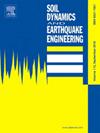Seismic retrofit of multi-story structures with KDamper-based vibration control systems considering soil–structure-interaction
IF 4.2
2区 工程技术
Q1 ENGINEERING, GEOLOGICAL
引用次数: 0
Abstract
This study introduces a novel retrofit seismic protection strategy utilizing the internal mechanism of the Extended KDamper (IEKD) to address the limitations of conventional mass-related vibration control systems and enhance the seismic resilience of multi-story structures. The IEKD is implemented between the foundation and the first floor, offering a lightweight alternative to classical approaches, such as the Tuned Mass Damper (TMD), which rely on large auxiliary masses and are highly sensitive to soil–structure-interaction (SSI) effects. Unlike traditional systems, the IEKD design explicitly accounts for SSI, ensuring robust performance across various soil conditions. A systematic optimization framework is developed to determine the IEKD parameters for different soil types, seismic inputs, and structural configurations. Ground motion excitation is represented by EC8-compatible artificial accelerograms. The performance of the IEKD is subsequently assessed with real earthquake records modified to reflect diverse soil conditions. A case study of a benchmark ten-story structure highlights the superior performance of the IEKD in reducing structural accelerations and floor drifts compared to conventional TMD systems, despite utilizing significantly lower additional mass (20 times lower). The findings of this study demonstrate that the IEKD is both effective and practical, offering a lightweight solution for seismic upgrade and establishing it as a compelling alternative for retrofitting existing multi-story structures.
考虑土-结构相互作用的k阻尼振动控制系统多层结构抗震改造
本研究介绍了一种利用扩展式阻尼器(IEKD)内部机制的新型改造地震保护策略,以解决传统质量相关振动控制系统的局限性,提高多层结构的抗震能力。IEKD在基础和一楼之间实施,提供了一种轻量级的替代方法,如调谐质量阻尼器(TMD),它依赖于大的辅助质量,对土壤-结构相互作用(SSI)效应高度敏感。与传统系统不同,IEKD设计明确考虑了SSI,确保了在各种土壤条件下的稳健性能。开发了一个系统优化框架,以确定不同土壤类型,地震输入和结构配置的IEKD参数。地震动激励用ec8兼容的人工加速度图表示。随后用实际地震记录对IEKD的性能进行了评估,以反映不同的土壤条件。一个基准的10层结构的案例研究表明,与传统的TMD系统相比,IEKD在减少结构加速度和地板漂移方面的卓越性能,尽管使用的额外质量显著降低(低20倍)。本研究的结果表明,IEKD既有效又实用,为抗震升级提供了一种轻量级解决方案,并将其确立为现有多层结构改造的一种令人信服的替代方案。
本文章由计算机程序翻译,如有差异,请以英文原文为准。
求助全文
约1分钟内获得全文
求助全文
来源期刊

Soil Dynamics and Earthquake Engineering
工程技术-地球科学综合
CiteScore
7.50
自引率
15.00%
发文量
446
审稿时长
8 months
期刊介绍:
The journal aims to encourage and enhance the role of mechanics and other disciplines as they relate to earthquake engineering by providing opportunities for the publication of the work of applied mathematicians, engineers and other applied scientists involved in solving problems closely related to the field of earthquake engineering and geotechnical earthquake engineering.
Emphasis is placed on new concepts and techniques, but case histories will also be published if they enhance the presentation and understanding of new technical concepts.
 求助内容:
求助内容: 应助结果提醒方式:
应助结果提醒方式:


